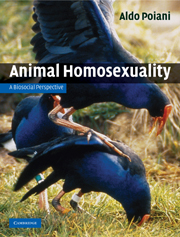Book contents
- Frontmatter
- Dedication
- Contents
- Contributors
- Acknowledgements
- Preface
- 1 Animal homosexuality in evolutionary perspective
- 2 The comparative study of homosexual behaviour
- 3 Genetics of homosexuality
- 4 Ontogenetic processes
- 5 The endocrine and nervous systems: a network of causality for homosexual behaviour
- 6 Immunology and homosexuality
- 7 Sexual segregation effects
- 8 The social, life history and ecological theatres of animal homosexual behaviour
- 9 Homosexual behaviour in primates
- 10 A Biosocial Model for the evolution and maintenance of homosexual behaviour in birds and mammals
- Appendix 1 Glossary
- Appendix 2 Predictions of the Synthetic Reproductive Skew Model of Homosexuality and results obtained in the comparative tests of the model carried out in birds and mammals
- Appendix 3 Comments on further results of comparative analyses of independent contrasts reported in the full correlation matrices of birds and mammals
- References
- Index
- Plates
7 - Sexual segregation effects
Published online by Cambridge University Press: 05 July 2014
- Frontmatter
- Dedication
- Contents
- Contributors
- Acknowledgements
- Preface
- 1 Animal homosexuality in evolutionary perspective
- 2 The comparative study of homosexual behaviour
- 3 Genetics of homosexuality
- 4 Ontogenetic processes
- 5 The endocrine and nervous systems: a network of causality for homosexual behaviour
- 6 Immunology and homosexuality
- 7 Sexual segregation effects
- 8 The social, life history and ecological theatres of animal homosexual behaviour
- 9 Homosexual behaviour in primates
- 10 A Biosocial Model for the evolution and maintenance of homosexual behaviour in birds and mammals
- Appendix 1 Glossary
- Appendix 2 Predictions of the Synthetic Reproductive Skew Model of Homosexuality and results obtained in the comparative tests of the model carried out in birds and mammals
- Appendix 3 Comments on further results of comparative analyses of independent contrasts reported in the full correlation matrices of birds and mammals
- References
- Index
- Plates
Summary
In some species of animals, including birds and mammals, the sexes may segregate for part or even most of the year (Ruckstuhl & Neuhaus 2005). Although a widely accepted definition of sexual segregation remains somewhat elusive (Bowyer 2004), owing in part to the diversity of behavioural patterns and mechanisms involved in this phenomenon, its essential features could be encapsulated in the following definition: sexual segregation is a greater distancing in space or time between members of different sexes than between members of the same sex. Such spatiotemporal distancing between the sexes may occur at all possible scales (Catry et al. 2005): from the micro (few hours or few metres) to the macro (many days or kilometres), and it will encompass both social and non-social species. Moreover, this definition also allows the use of appropriate statistical tools (e.g. multidimensional scaling) in order to determine whether a population does indeed display sexual segregation at any specific spatiotemporal scale or not.
Along the time axis, we should also consider the possibility that sexual segregation may vary ontogenetically, with taxon-specific tendencies for sexual segregation to be more prevalent at some ages than at others. For instance, larger and older adult beluga whale (Delphinapterus leucas) males segregate from females in summer in the Canadian high Arctic, but younger males do not (Loseto et al. 2006). Obviously, when individuals in a population are not sexually segregated, it means that they are sexually aggregated (Bowyer 2004). Following the above definition of sexual segregation, in species such as the Douglas’s squirrel (Tamiasciurus douglasii) (Koford 1982) where members of a local population hold individual territories that are not clumped into sex-specific clusters but instead male and female territories are spatially interspersed, we cannot talk of sexual segregation. Rather, species such as T. douglasii show individual segregation irrespective of sex (i.e. they are individually segregated but sexually aggregated).
- Type
- Chapter
- Information
- Animal HomosexualityA Biosocial Perspective, pp. 283 - 322Publisher: Cambridge University PressPrint publication year: 2010



